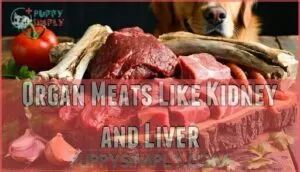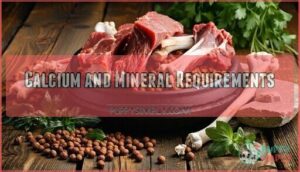This site is supported by our readers. We may earn a commission, at no cost to you, if you purchase through links.
 You’ll transform your dog’s health by switching to a raw dog feeding guide that mirrors their ancestral diet.
You’ll transform your dog’s health by switching to a raw dog feeding guide that mirrors their ancestral diet.
Start with quality muscle meat (70-80%), add organ meats like liver and kidney (10-15%), and include raw bones for calcium.
Gradually introduce the new food over 7-10 days, mixing raw with current food.
This species-appropriate nutrition supports stronger immunity, better digestion, and shinier coats.
Monitor your dog’s energy levels and stool consistency during the switch.
Balance is key—too much liver can cause loose stools, while proper ratios reveal remarkable health.
The secret lies in understanding precise nutritional ratios and safe handling techniques.
Table Of Contents
- Key Takeaways
- Raw Dog Food Benefits
- Choosing Raw Meat
- Transitioning to Raw
- Balancing Raw Diets
- Feeding Guidelines
- Frequently Asked Questions (FAQs)
- How much raw food to feed my dog chart?
- How much raw should I feed my dog a day?
- What are the guidelines for a raw diet for dogs?
- Can raw fed dogs eat commercial treats?
- How long does raw dog food stay fresh?
- Is freezing raw meat safe for dogs?
- What supplements do raw fed dogs need?
- Can sick dogs eat raw food diets?
- Conclusion
Key Takeaways
- Start with the right ratios: You’ll need 70-80% muscle meat, 10-15% organ meats like liver and kidney, and 10-15% raw bones to create a balanced diet that mirrors your dog’s ancestral needs.
- Transition gradually over 7-10 days: You can mix raw food with your dog’s current food, increasing the raw portion by 25% every two days to prevent digestive upset and allow their system to adjust.
- Monitor your dog’s response closely: You’ll see firmer, smaller stools and increased energy levels as signs of a successful transition, but watch for loose stools that indicate too much organ meat.
- Feed 2-3% of ideal body weight daily: You’ll split this into two meals for adult dogs, while puppies need 4-6% of their current weight divided into more frequent feedings throughout the day.
Raw Dog Food Benefits
Raw dog food benefits stem from providing natural, unprocessed ingredients that closely mirror your dog’s ancestral diet and genetic makeup.
This approach supports stronger immune function while delivering essential nutrients in their most bioavailable forms, which is a key aspect of the raw dog food benefits.
Natural Unprocessed Ingredients
When you break free from commercial kibble’s processed chains, fresh meat becomes your dog’s foundation for peak health.
Raw ingredients like organic produce and raw bones deliver nutrients in their most bioavailable form.
Whole foods provide complete nutrition without synthetic additives or preservatives that can compromise your pet’s wellbeing over time, focusing on complete nutrition.
Immune System Support
Raw diets naturally boost your dog’s immune function through enhanced nutrient absorption and gut health benefits.
Unprocessed ingredients preserve essential nutrients and antioxidants that commercial processing destroys, giving your pet’s immune system the raw materials it needs.
- Probiotic Benefits – Fresh raw foods contain natural probiotics that support healthy gut bacteria populations
- Immune Boosters – Raw organ meats deliver concentrated vitamins A, C, and E for disease prevention
- Phytochemicals – Raw vegetables provide plant compounds that strengthen immune response naturally
- Essential Nutrients – Bioavailable minerals and vitamins remain intact without heat processing damage
Genetic Similarity to Wolves
Dogs share remarkable DNA similarity with wolves, maintaining 99.9% genetic overlap despite thousands of years of domestication.
Your dog’s DNA is 99.9% wolf—their wild instincts still drive their nutritional needs.
This Wolf Genetics connection explains why your dog’s digestive system still craves wild prey like their Wild Ancestors.
Canine Evolution hasn’t altered their carnivore diet needs.
Biologically Appropriate Raw Food and Prey Model Raw PMR diets honor this Species Comparison, providing raw dog food that matches what wolves consume naturally.
The raw food diet provides numerous canine raw food diet benefits, including improved digestive health through raw food nutrition.
Choosing Raw Meat
Selecting the right raw meat forms the foundation of your dog’s nutritional success, with quality protein sources like chicken, beef, and fish providing essential amino acids for peak health.
You’ll need to balance muscle meat with organ meats such as liver and kidney, which deliver critical vitamins and minerals that muscle meat alone can’t provide, ensuring a complete nutritional profile.
Chicken and Beef Options
When choosing between chicken and beef for your raw dog food, consider your dog’s specific needs and your budget.
Chicken offers lean protein with high digestibility, making it perfect for weight management and sensitive stomachs.
Beef provides higher iron, zinc, and essential fatty acids that support muscle development.
Both proteins deliver complete amino acid profiles, but chicken’s lower fat content suits less active dogs while beef’s richness benefits high-energy breeds requiring more calories.
For proper nutrition, consult raw chicken guidelines to guarantee a balanced diet and support your dog’s overall health with complete amino acid profiles.
Organ Meats Like Kidney and Liver
Something remarkable happens when you include organ meats in your dog’s raw diet – these nutrient-dense powerhouses deliver concentrated Organ Benefits that muscle meat can’t match.
Liver Nutrition provides essential vitamin A and B-vitamins, while kidney supports healthy Kidney Function through selenium and B12.
These secreting organs contain minerals like iron, copper, and phosphorus at levels far exceeding regular meat. When balanced properly with raw meaty bones RMB, organ meat creates essential Nutrient Balance, acting as nature’s Raw Supplements for complete canine nutrition.
Including organ meat benefits in a raw dog food diet is vital for overall health and well-being.
Fish and Poultry Choices
Fish and poultry offer excellent protein sources for your raw dog food journey.
Salmon provides omega-3 fatty acids, while chicken delivers lean protein your dog craves.
You’ll want to rotate between different meat varieties to guarantee complete nutrition and prevent food sensitivities from developing over time.
- Fish Oil Benefits: Salmon and sardines boost coat shine and joint health through natural omega-3s
- Poultry Selection: Chicken, turkey, and duck provide lean protein with different amino acid profiles
- Raw Fish Safety: Choose wild-caught varieties and freeze for 48 hours to eliminate parasites
- Fowl Nutrition Balance: Mix white and dark meat to achieve ideal fat ratios in your raw feeding guide
Transitioning to Raw
You can switch your dog to raw food using either a gradual approach over 7-10 days or switch immediately if your dog has a healthy digestive system.
Both methods work effectively, though monitoring your dog’s response helps you adjust the pace based on their individual tolerance and stool consistency.
Gradual Approach Method
Up to 90% of nutritionists recommend a phased conversion for raw introduction, completing the switch within 7-14 days.
Start with 25% raw food, increasing by 25% every two days until reaching 100% raw.
This gradual switching approach provides digestive ease and reduces gastrointestinal upset compared to immediate changes.
Your meal planning should monitor stool consistency closely during this raw diet changeover period.
Immediate Switch Technique
Some dogs thrive with a cold turkey approach to raw diet switch.
This instant switch method eliminates kibble completely on day one, allowing your dog’s digestive system to adapt quickly to raw feeding.
Many experienced raw feeders prefer this fast switch technique, believing it prevents digestive confusion from mixing food types.
Monitor your dog closely during the first week for any adjustment signs.
A well-planned raw dog food diet supports ideal growth and health.
Monitoring Digestive Adjustments
After switching to raw feeding, watch your dog’s digestive health closely.
Stool quality changes are normal – expect firmer, smaller bowel movements as gut balance improves.
Monitor for digestive issues like loose stools or discomfort during the first week.
Better nutrient absorption typically leads to healthier dog digestion within days.
Balancing Raw Diets
Creating a balanced raw diet requires understanding the precise ratios of muscle meat, organs, bones, and plant ingredients your dog needs for peak health.
You’ll need to carefully calculate protein, fat, calcium, and mineral content while incorporating essential organ meats and vegetables to prevent nutritional deficiencies.
Fat and Protein Balance
Achieving ideal macronutrients requires precise fat ratios alongside quality protein sources.
Your dog’s raw diet benefits from 10-20% total fat content, balancing saturated fats from muscle meat with omega-rich supplements.
Essential nutrients work together—protein builds muscle while fats support absorption of fat-soluble vitamins.
This nutrient balance forms the foundation of effective canine nutrition, making your dog nutrition guide complete.
Calcium and Mineral Requirements
Getting your calcium and phosphorus balance right isn’t rocket science, but it’s make-or-break for bone health.
Raw meaty bones at 10-15% of total diet supply the calcium your dog needs, while muscle meat provides phosphorus.
You’re aiming for a 1.2:1 calcium-to-phosphorus ratio. Skip the guesswork—raw bones naturally deliver essential nutrients and proper mineral balance for a truly balanced diet.
Adding Organ Meats and Vegetables
Adding organ meats and vegetables to your dog’s raw diet reveals nutritional powerhouses that commercial kibble can’t match.
Organ meat like liver provides concentrated vitamins, while properly prepared vegetables offer digestive health benefits.
Steam or puree vegetables for better nutrient absorption in your dog’s system.
These raw supplements create the nutrient balance your canine digestive system craves naturally.
A balanced raw diet requires understanding of proper raw dog nutrition to guarantee health that’s at its best, with a focus on raw diet.
Balancing Saturated and Omega Fats
Fat ratios determine your dog’s long-term health outcomes.
Balanced raw dog feeding requires 30-40% saturated fat, 30-50% monounsaturated fats, and 10-30% polyunsaturated omega fats.
Essential nutrients work best with 2:1 to 6:1 omega-6 to omega-3 ratios.
Grass-fed meats provide better nutrient profiles than grain-fed options.
Omega sources like fish oil enhance fatty acid balance in your dog’s diet.
Feeding Guidelines
Getting your dog’s portions right makes all the difference between a thriving pet and one that’s under or overfed.
You’ll need to calculate feeding amounts based on your dog’s weight, age, and activity level to guarantee they get proper nutrition without excess calories, which is crucial for a thriving pet.
Adult Dog Feeding Amounts
Adult dogs need 2-3% of their ideal body weight in raw food daily. A 50-pound dog requires 1-1.5 pounds per day, while a 10-pound dog needs 3.2-4.8 ounces.
Less active or senior dogs may thrive on 1.5-2% for proper weight management.
Split daily feeding amounts into two meals for better digestion and nutrient absorption.
Puppy Feeding Recommendations
Growing puppies need 4-6% of their current body weight daily in raw food, with younger pups requiring higher percentages.
Feed 4 meals daily under 4 months, reducing to 3 meals at 4-6 months, then 2 meals after 6 months.
Puppy-specific raw formulas provide proper calcium, phosphorus, and protein ratios essential for healthy development and growth stages.
It’s vital to follow a proper newborn puppy feeding schedule to guarantee healthy growth and health.
Raw Vegetables and Polyphenols
Your dog’s digestive system thrives when you include properly prepared raw vegetables rich in polyphenols and antioxidants.
These plant compounds support immune function and provide essential phytochemicals that complement meat-based nutrition for peak health. A balanced diet may also benefit from additional vegetable supplements.
- Leafy Greens: Spinach, kale, and parsley deliver magnesium and flavonoids your dog needs
- Veggie Prep: Puree, steam, or ferment vegetables to break down cell walls for better nutrient absorption
- Polyphenol Benefits: Blueberries and broccoli provide powerful antioxidants that fight inflammation
- Raw Fiber: Properly prepared plant matter aids digestion and supports gut health
- Nutrient Boost: Colorful vegetables fill nutritional gaps in meat-only diets
Avoiding Starchy Carbohydrates
Unlike kibble-heavy diets, raw feeding thrives on Low Carb Diets and Starch Free Foods.
Skip potatoes, rice, and corn—these starchy vegetables require excessive cooking for dogs’ digestive systems.
Your natural dog diet should embrace Grain Free Options with strict Carbohydrate Limits.
Focus on Sugar Reduction by choosing raw meats and organs.
This raw feeding guide prioritizes what your canine nutrition guide recommends: protein-rich, starch-free meals that support peak health.
Frequently Asked Questions (FAQs)
How much raw food to feed my dog chart?
Feed your dog 2-3% of their ideal body weight daily in raw food.
A 50-pound dog needs 1-5 pounds daily, while a 10-pound dog requires 2-8 ounces.
Adjust based on activity level.
How much raw should I feed my dog a day?
Adult dogs need 2-3% of their ideal body weight daily in raw food.
A 50-pound dog requires 1-5 pounds daily.
Puppies need 4-6% of current weight.
Adjust based on activity level and body condition.
What are the guidelines for a raw diet for dogs?
You’ll want to follow the 2-3% rule for your dog’s body weight daily. Include 70% muscle meat, 10% raw bone, 10% organs, plus vegetables and seeds for complete nutrition.
Can raw fed dogs eat commercial treats?
Yes, you can offer commercial treats to your raw-fed dog, but choose wisely.
Select treats with minimal ingredients, avoiding artificial additives and fillers.
Many raw feeders prefer freeze-dried or dehydrated options that align better with natural feeding principles, following minimal ingredients guidelines.
How long does raw dog food stay fresh?
Raw dog food stays fresh in the refrigerator for 3-5 days after thawing. You’ll want to freeze portions immediately and only thaw what you need for a few days ahead.
Is freezing raw meat safe for dogs?
Freezing provides a clever preservation method that locks in freshness while eliminating harmful bacteria. You’re absolutely free to freeze raw meat for your dog safely, maintaining nutritional quality for months.
What supplements do raw fed dogs need?
Most raw-fed dogs thrive without supplements when fed a balanced BARF diet. You might consider fish oil for omega-3s and vitamin E for antioxidants if needed.
Can sick dogs eat raw food diets?
Like walking a tightrope, feeding raw to sick dogs requires veterinary guidance. While some conditions may benefit from raw’s digestibility, others need specific restrictions. Always consult your vet first.
Conclusion
Apparently, your dog’s digestive system didn’t receive the memo about modern convenience foods being superior to nature’s original blueprint.
Following this raw dog feeding guide transforms your pet’s health through species-appropriate nutrition that actually works with their biology rather than against it.
You’ll witness improved digestion, stronger immunity, and increased energy levels when you commit to proper ratios and safe handling practices.
Success requires patience during the adjustment period and attention to your dog’s individual responses to dietary changes.
- https://ocraw.com/feeding-guide/
- https://ironwillrawdogfood.com/blogs/news/how-much-raw-food-should-i-feed-my-dog
- https://perfectlyrawsome.com/raw-feeding-knowledgebase/biologically-appropriate-raw-food-barf-adult-dogs/
- https://www.webmd.com/pets/dogs/features/raw-dog-food-dietary-concerns-benefits-and-risks
- https://www.dogsnaturallymagazine.com/raw-feeding-primer/















